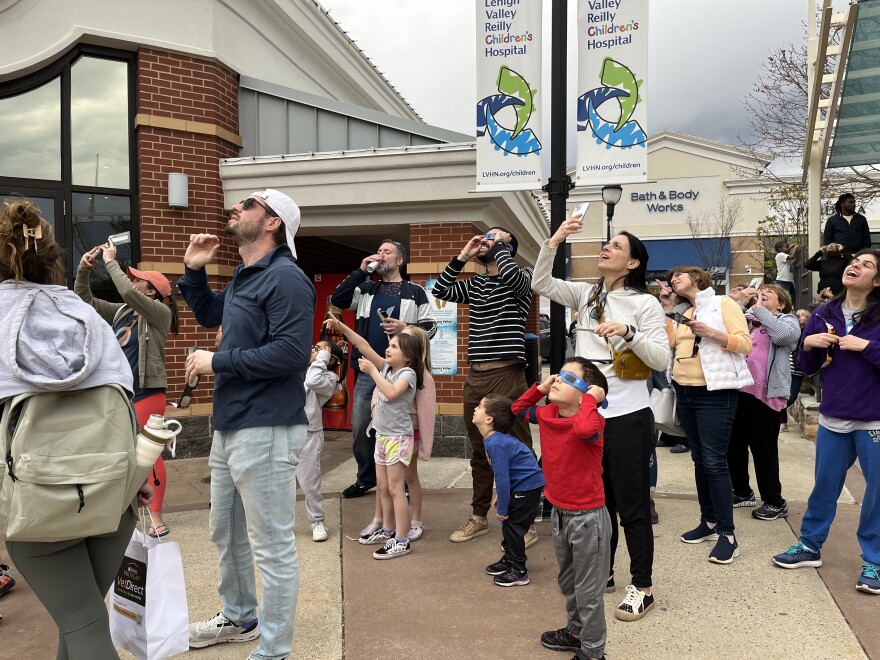LOWER NAZARETH TWP., Pa. — Looking up at a clear night sky sprinkled with stars, it’s easy to be overtaken by the feeling of being small, almost insignificant, compared to the enormity of the universe.
“In some ways, that's good,” said David Buckley, East Stroudsburg University’s resident astronomer.
“But the other the other way you can kind of counter that argument is that we are, yes, very small, and maybe you might think insignificant.
"But we've actually been able to figure out what these things are that we're looking at, and actually measure them and have an idea of what they are, and know that these little tiny dots of light are other suns and that our planet is actually made of the dust of exploded stars that happened before our solar system even formed.
“There's a much closer connection to it than people would think. That's another thing I enjoyed talking to people about.”
With a couple telescopes and a student assistant alongside him, Buckley on Friday night is leading a stargazing program at Louise W. Moore Park, 151 Country Club Road. Depending on the weather, participants could see the waxing gibbous moon, as well as several constellations.
“Unfortunately, we don't have any bright planets this time,” said Buckley, also a physics professor at ESU. “Last fall would have been really good because Jupiter and Saturn were both out.”
But this time, it's mainly the moon and if it's nice and clear, we'll see some star clusters.”
One of astronomy’s ‘biggest frustrations’
The Valley’s residents have had several chances to see celestial events so far this year, including the first visible eclipse since Aug. 21, 2017, and a rare glimpse of the Northern Lights.

During the April eclipse, 92% of the sun was obscured by the moon. However, cloud cover obscured residents’ view for much of the event – several deeming it a disappointment.
Last weekend, the Northern Lights produced dazzling displays across the Northern Hemisphere for many areas that don’t normally see them.
They were briefly visible in Easton and Bethlehem about 3 a.m. Saturday morning, but those who were sleeping missed out. And, again, the Valley was cloaked with clouds and scattered showers before a solar storm peaked after 4 a.m. Sunday.
“One of the biggest frustrations of doing astronomy in northeastern Pennsylvania is the weather – it's not Arizona. The weather is not as conducive to astronomy as it would be in some other areas of the country.”David Buckley, East Stroudsburg University’s resident astronomer
“One of the biggest frustrations of doing astronomy in northeastern Pennsylvania is the weather — it's not Arizona,” Buckley said. “The weather is not as conducive to astronomy as it would be in some other areas of the country.”
Forecasters at the National Weather Service in Mount Holly predict a warm Friday, reaching highs of 73 degrees, before dropping to a low of around 56 degrees overnight. Unfortunately, they’re also expecting mostly cloudy conditions.
Anyone registered for the county’s stargazing program will be notified if it’s canceled due to weather, officials said.
‘This sense of wonder’
Sponsored by Northampton County’s Parks and Recreation Division, Friday’s stargazing program is free and open to all ages 6 and up, but registration is required.
While the program started almost a decade ago, in 2015, it’s generally held at Minsi Lake Park in Upper Mount Bethel Township, “which has the darkest skies and best night sky viewing in the county,” parks and recreation staff said in a statement.
“But we wanted to expand to other county parks,” officials said. “So, Dr. Buckley scoped out the night sky here at Louise Moore Park last year. He determined that his telescopes would be able to see the stars and constellations well despite there being much more light pollution here in the middle of the county than in the much more rural and far less ‘lit up’ northeastern corner of the county at Minsi Lake.”
Along with more familiar heavenly bodies, like the Big Dipper and the North Star, participants might be able to glimpse Algieba, a binary star, or two stars that orbit each other, in the constellation Leo.
“They're very pretty to see in the telescope because they have slightly different colors,” Buckley said. “And basically just seeing two stars that are kind of in the same system. You can see them even in a fairly hazy sky.”
While Buckley has seen these stars many times before, it’s fun to help those who haven’t, and to be there to explain what they’re seeing, he said.
“Sometimes this may be the only time in their life they ever look at the moon through a telescope,” Buckley said. “There aren't that many people who have telescopes, and the ones who do are usually in the backyards looking on their own.
“And so it's really kind of a thrill to show people the actual moon, or a star cluster that's tens of thousands of light years away. They get this sense of wonder.”
There are two more stargazing programs scheduled this year. One at Minsi Lake Park on Aug. 9 and another at Delps Park in Lehigh Township on Oct. 11.


